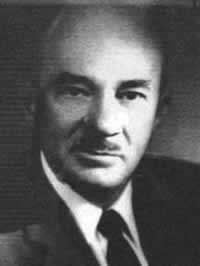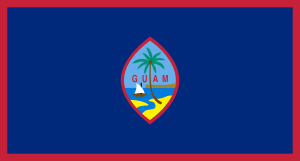Richard Barrett Lowe
| Richard Barrett Lowe | |
|---|---|
 | |
| 3rd Appointed Governor of Guam | |
|
In office October 15, 1956 – November 14, 1959 | |
| Preceded by |
Ford Quint Elvidge William Corbett (acting) |
| Succeeded by |
Marcellus Boss (acting) Joseph Flores |
| 42nd Governor of American Samoa | |
|
In office October 1, 1953 – October 15, 1956 | |
| President | Dwight Eisenhower |
| Preceded by | Lawrence M. Judd |
| Succeeded by | Peter Tali Coleman |
| Personal details | |
| Born |
July 8, 1902 Madison, South Dakota |
| Died |
April 16, 1972 (aged 69) Alexandria, Virginia |
| Nationality | American |
| Political party | Republican |
| Alma mater | Eastern State Teacher's College |
| Occupation | Educator |
| Military service | |
| Allegiance |
|
| Service/branch |
|
| Rank |
|
| Commands | V-12 Navy College Training Program at University of Nebraska and Creighton University |
Richard Barrett Lowe (July 8, 1902 – April 16, 1972) was the 42nd Governor (and fifth appointed civil governor)[1] of American Samoa (October 1, 1953 – October 15, 1956) and the eighth American Governor (and third civilian governor)[2] of Guam (October 15, 1956 – November 14, 1959). He was also a prominent educator and United Nations observer.
Life
Early life
Lowe was born on July 8, 1902 in Madison, South Dakota, the youngest of three children. Lowe graduated from Madison High School, and studied at the University of Wisconsin for one year before transferring to the Normal school at Eastern State Teacher's College, where he graduated in 1929. During his senior year, he wrote the premise for and directed the film Dacotah, believed to be the first full-length motion picture filmed entirely on a college campus.[1] Lowe later received his master's degree from the University of South Dakota; he received an honorary Doctor of Education from Ottawa University in 1942.[1]
Education career
Following his graduation from Eastern State, Lowe served as an educator and superintendent in various places in South Dakota, eventually becoming president of the South Dakota Education Association.[3] In February 1946, Lowe became the dean of the Nebraska State Teachers College in Peru, Nebraska.[1] While helping with a Naval Reserves recruiting drive, Lowe convinced those in charge to emphasize the importance of education by using the slogan "Stay in School". Lowe was offered the office of Director of Education, first of American Samoa, and later of Guam in the 1950s, but turned down both positions in hopes of obtaining a governorship.[1]
After his governorships, Lowe became the United Nations observer for the National Education Association in 1964.[4]
Military service
During World War II, Lowe served in the United States Navy as the commanding officer of the V-12 Navy College Training Program at the University of Nebraska and Creighton University.[1] He also served as an officer on Tinian, Guam, and Okinawa Island. In 1947, Lowe assisted in a recruitment drive for the United States Navy Reserve, where he convinced the Navy Recruiting Office to adopt the slogan "Stay in School".[1]
Governorship
For a little less than two weeks in 1953, Lowe was the Governor of two territories simultaneously, the only time this has happened in the 20th century.
American Samoa (1953–56)
Lowe became governor of American Samoa in 1953. While governor, he helped foster the tuna canning industry, now one of American Samoa's primary sources of employment.[5]
Guam (1956–60)
Ford Quint Elvidge resigned the governorship in 1956, and President Dwight Eisenhower appointed Lowe to the governorship.[6] While governor, Lowe appointed many Chamorros to high public office, including the appointment of Manuel Flores Leon Guerrero as Assistant Secretary of Guam.[6] Upon Lowe's resignation in 1960, Eisenhower appointed Joseph Flores, the first Chamorro Governor of the island, as Lowe's replacement.[7]
Later life
After retiring from politics, Lowe began restoring houses in the Washington D.C. area, including the George Washington Town House in Alexandria, Virginia. Rebuilt in 1960, Lowe used bricks and stones from an excavation of the house and erected the structure on the original foundation.[8] Lowe died in Alexandria, Virginia on April 16, 1972 at the age of 69. He is buried at Graceland Cemetery in Madison, South Dakota.
Bibliography
- Papers, 1936–70.
- Problems in Paradise : The View from Government House. New York: Pageant Press. 1967.[9]
Notes
- 1 2 3 4 5 6 7 Dakota State University (2004).
- ↑ Wuerch and Ballendorf (1994), 44.
- ↑ National Education Association (1962), 5.
- ↑ The Nation's Schools (1963), 114.
- ↑ Van Cleve (1974), 66.
- 1 2 Cunningham and Beaty (2001), 298.
- ↑ The Virigin Islands Daily News (1960), 1.
- ↑ ACVA (2009).
- ↑ National Library of Australia (2009).
References
- Alexandria Convention and Visitors Center (2009). "George Washington Walking Tour". Retrieved 5 August 2009.
- Cunningham, Lawrence; Janice Beaty (2001). A History of Guam. Bess Press. ISBN 1-57306-068-2. Retrieved 4 August 2009.
- Dakota State University (2004). "Richard Barrett Lowe". American Samoa. Retrieved 31 July 2009.
- The Nation's Schools (71 ed.). McGraw Hill. 1963.
- National Education Association (1962). Today's Education. 51. National Education Association of the United States.
- "President Names Flores New Governor of Guam". The Virgin Islands Daily News. 15 June 1960. Retrieved 5 August 2009.
- "Problems in paradise : the view from Government House / by Richard Barrett Lowe ; with a foreword by Wayne N. Aspinall". Catalogue. National Library of Australia. 2009. Retrieved 4 August 2009.
- Van Cleve, Ruth (1974). The Office of Territorial Affairs. Praeger Publishing.
- Wuerch, William; Dirk Anthony Ballendorf (1994). Historical dictionary of Guam and Micronesia. Lanham: Rowman & Littlefield. ISBN 0-8108-2858-8. Retrieved 5 August 2009.
| Government offices | ||
|---|---|---|
| Preceded by Lawrence M. Judd |
Governor of American Samoa 1953–1956 |
Succeeded by Peter Tali Coleman |
| Preceded by William Corbett (Acting) |
Governor of Guam 1956–1959 |
Succeeded by Marcellus G. Boss (Acting) |

